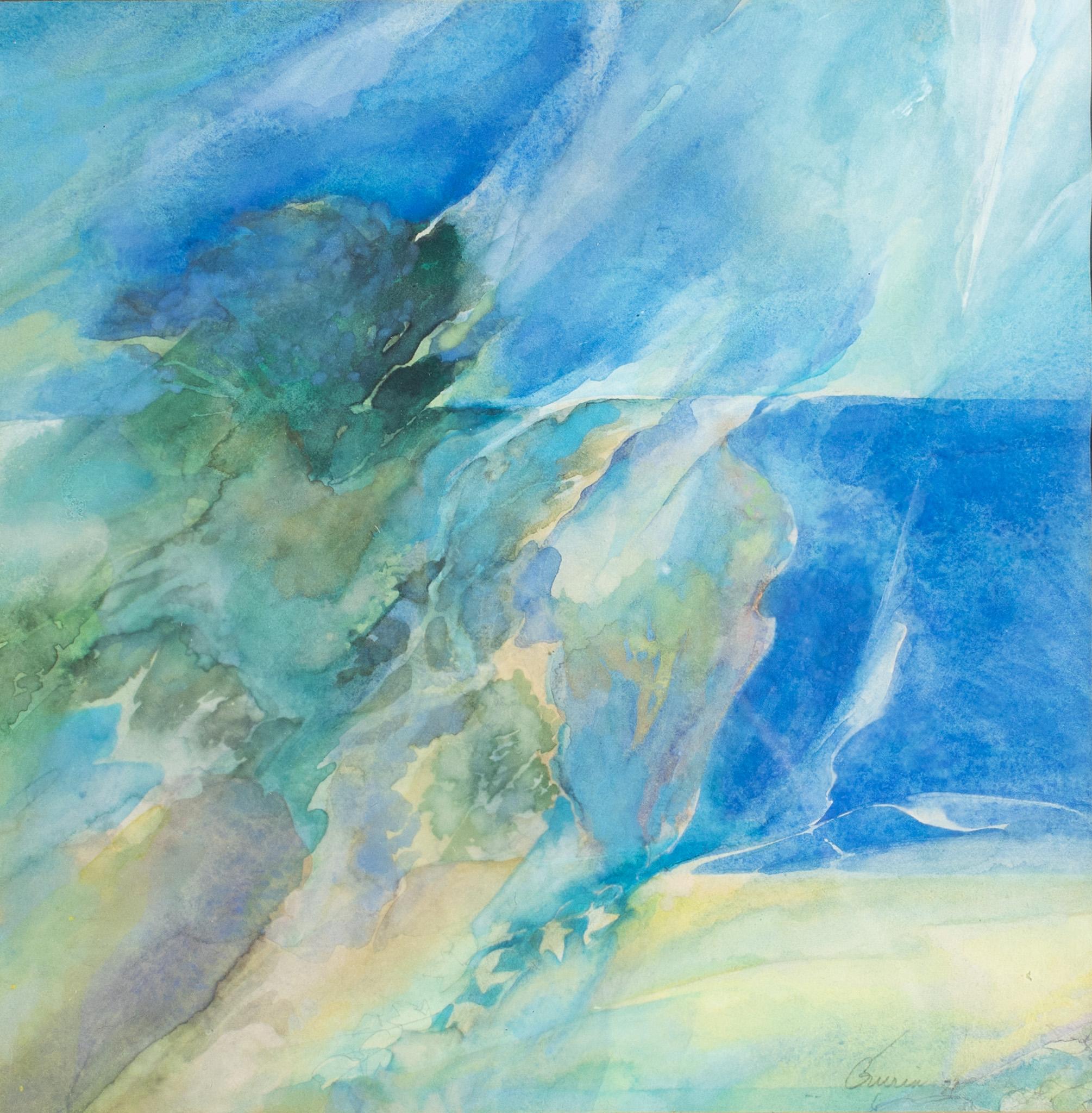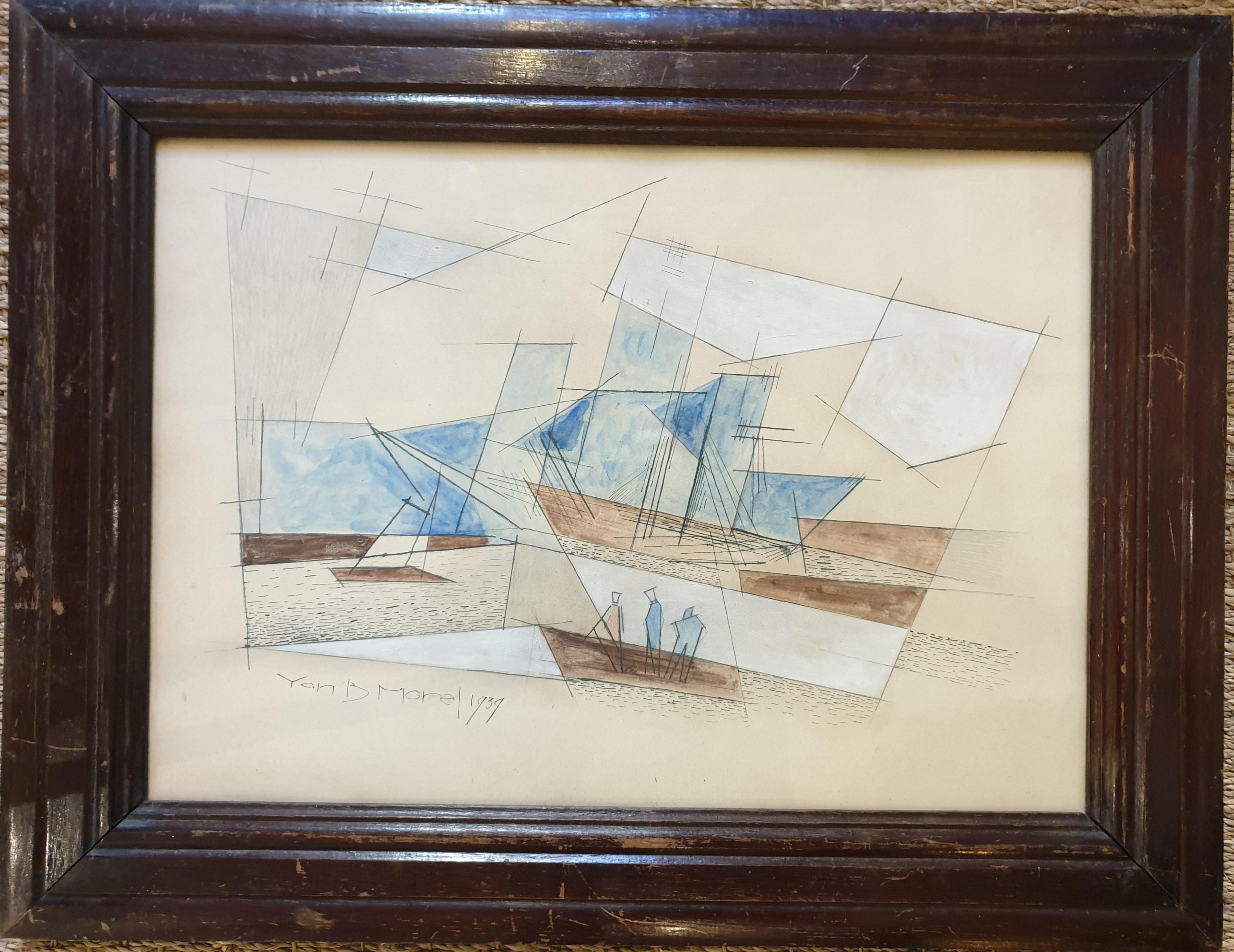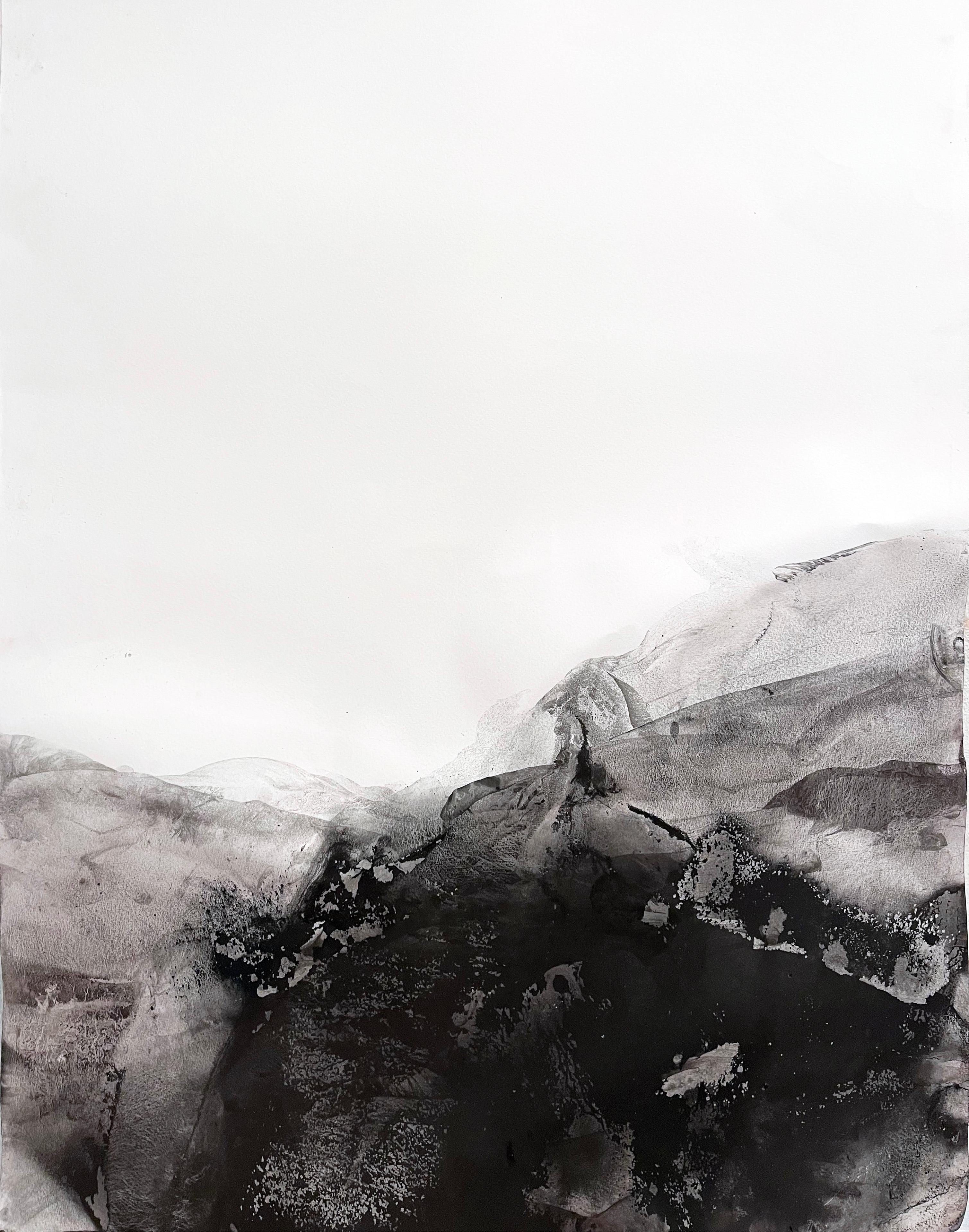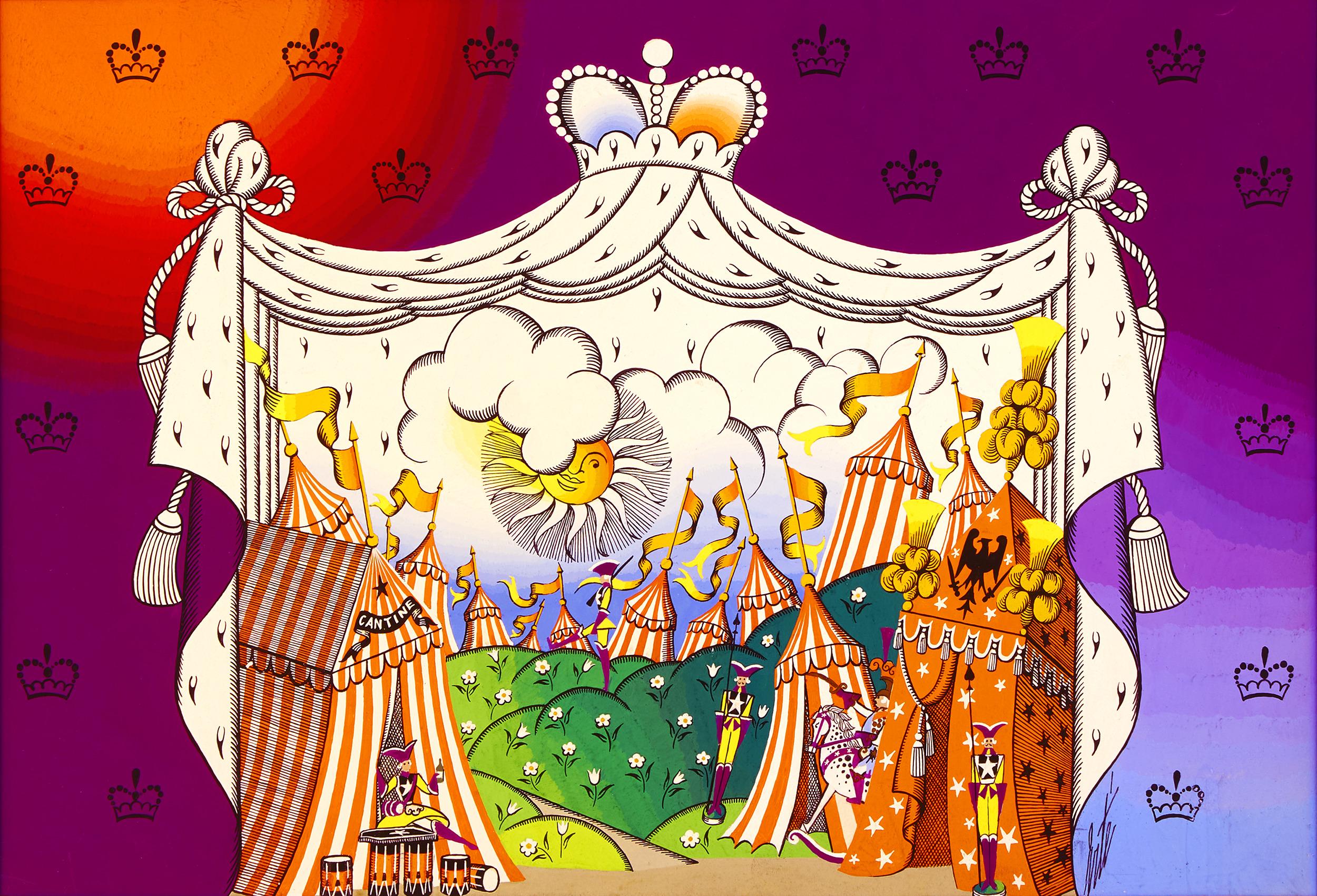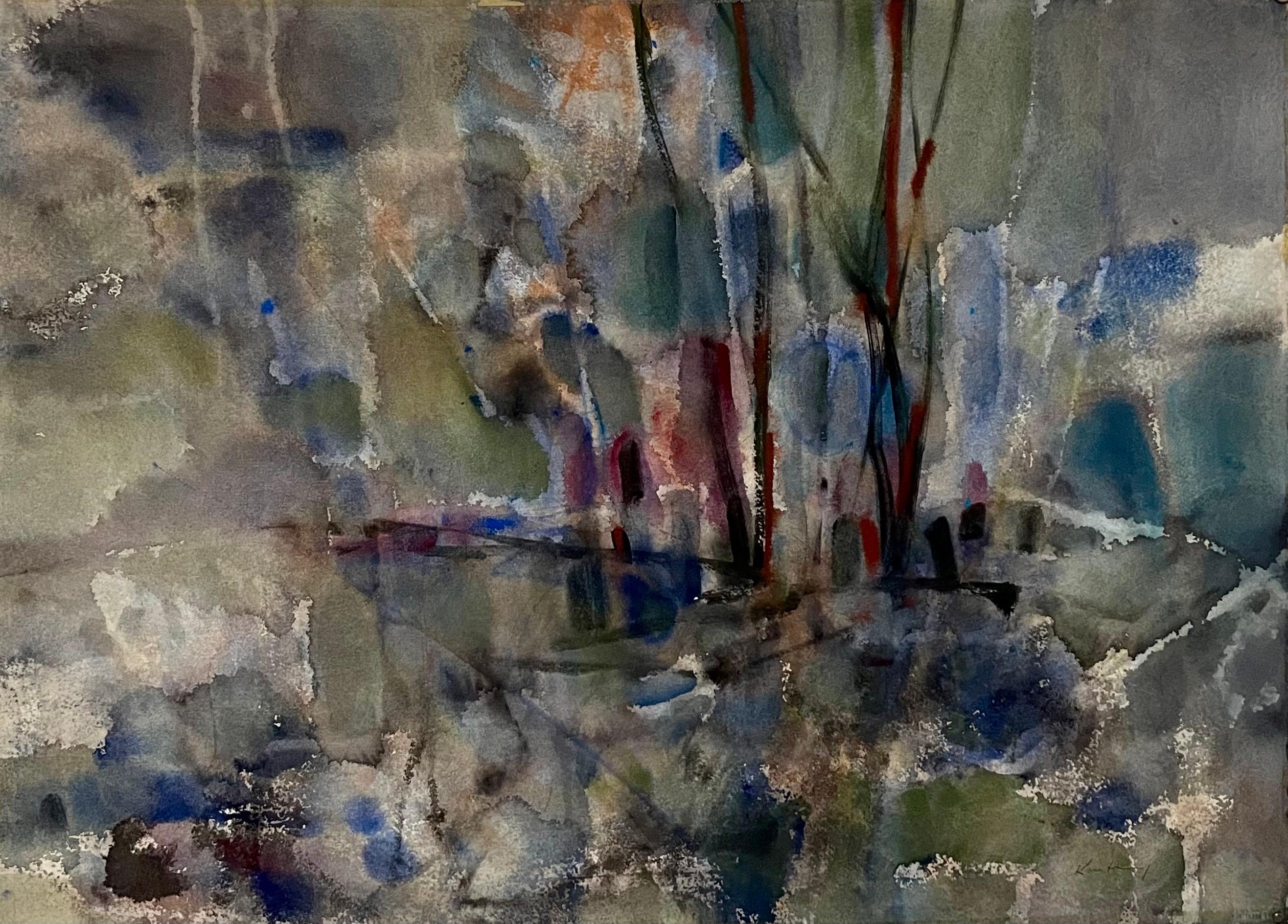Items Similar to 'Raining in Formosa on the Tamsui River' by Ran In-Ting (Lan Yinding, 藍蔭鼎)
Want more images or videos?
Request additional images or videos from the seller
1 of 24
Ran In-Ting'Raining in Formosa on the Tamsui River' by Ran In-Ting (Lan Yinding, 藍蔭鼎)1956-1959
1956-1959
About the Item
'Raining in Formosa on the Tamsui River' by Taiwanese artist, Ran In-Ting (Lan Yinding, 藍蔭鼎) (1956-59). Although elements of landscapes often appear in paintings produced by various cultures, before the 17th century in the West they were only peripheral. In 5th century China, shan shui or landscape painting developed, expressing harmony and natural beauty. These were among the first paintings to make landscape their subject (ref: 'The Short Story of Art' by Susie Hodge, 2017). In that tradition the artist painted this delicate monochrome watercolour directly for the British Naval Attaché in Formosa (Taiwan) from 1956-1959 and friend of the artist. It was subsequently left to his family. The provenance is therefore impeccable. The work is inscribed 'Ran In-Ting / Formosa' (lower left) and also signed in Chinese with the artist's seal. It has been newly framed with a French-style linen slip and glazed with museum glass which is anti-UV and non-reflective in order to preserve the work for decades to come. Upon request a video of the piece may be provided. The artist's works frequently sell for tens of thousands of US dollars at international auctions. This particular work is both an investment and a beautiful work of art.
About the Artist: Ran In-Ting (Lan Yinding, 藍蔭鼎) (1903 – 1979) was born in Ratō, Giran-chō, Japanese-ruled Taiwan in North-Eastern Taiwan. He is said to have painted his first picture at the age of 13, a mural on a temple wall in his home village of a dragon wreathed by cloud. His father, a scholar of Qing, China, is said to have taught Ran Chinese ink painting as a child. He was able to study art at secondary school, and became an art teacher at Ratō Public School at the age of 17. Japanese watercolour artist, Kinichiro Ishikawa, spent almost 18 years working and teaching art in Taiwan. In 1924, Ishikawa spotted Ran's watercolours at a school inspection, and was very taken with them. Ran then studied watercolour painting under Ishikawa's tutelage. Ishikawa had studied in England, and taught his students to paint in watercolours in the Western style, which was seen as very important in Japan at that time. Ran's work has been exhibited throughout the world, and his paintings are in the collections of the major museums of the world including the Prado in Madrid and the Museum of Modern Art in New York. He was commissioned to paint works in the US and was a member of the major watercolour art societies in the UK, France and Italy. In 1959 he received the National Art Prize from the Republic of China, and in 1969 received an honorary degree from the College of Chinese Culture Taipei. In 1991 the National Palace Museum in Taipei staged a major exhibition of Ran's watercolours, and in 1998 the National Museum of History held a retrospective exhibition of Ran In-ting's work (ref: Wikipedia).
Dimensions with Frame:
H 32 cm / 12.6"
W 41.5 cm / 16.3"
Dimensions without Frame:
H 18.5 cm / 7.3"
W 28 cm / 11"
- Creator:Ran In-Ting (1903 - 1979, Taiwanese)
- Creation Year:1956-1959
- Dimensions:Height: 12.6 in (32 cm)Width: 16.34 in (41.5 cm)
- Medium:
- Period:
- Condition:The work has been newly framed with a French-style linen slip and glazed with museum glass which is anti-UV and non-reflective in order to preserve the work for decades to come.
- Gallery Location:London, GB
- Reference Number:
About the Seller
5.0
Platinum Seller
These expertly vetted sellers are 1stDibs' most experienced sellers and are rated highest by our customers.
Established in 2016
1stDibs seller since 2017
438 sales on 1stDibs
Typical response time: <1 hour
- ShippingRetrieving quote...Ships From: London, United Kingdom
- Return PolicyA return for this item may be initiated within 7 days of delivery.
More From This SellerView All
- Las Ramblas BarcelonaLocated in London, GB'Las Ramblas Barcelona', watercolour on art paper, by Spanish artist, Josè Goday (1984). A wonderful snippet of the magical street in Barcelona called Las ...Category
1980s Landscape Drawings and Watercolors
MaterialsPaper, Watercolor
- Notre Dame de Paris IIBy Lucien GéninLocated in London, GB'Notre Dame de Paris II', gouache on paper, by Lucien Génin (circa 1930s). One of two paintings of Notre Dame by this artist held by our gallery, it is also an absolutely charming and now, historic depiction from the 1930s, of the most famous cathedral in France. This version uses more exaggerated brushstrokes with strong colours attesting to its expressionist roots. Notre Dame is one of the most widely recognised symbols of the city of Paris and the French nation. As the cathedral of the Archdiocese of Paris, Notre-Dame contains the cathedra of the Archbishop of Paris. Approximately 12 million people visit Notre-Dame annually, making it the most visited monument in the city. While undergoing renovation and restoration, the roof of Notre-Dame caught fire on the evening of 15 April 2019. Burning for around 15 hours, the cathedral sustained serious damage. The government of France hopes the reconstruction can be completed by Spring 2024, in time for the opening of the 2024 Summer Olympics in Paris. Unlike the actual cathedral, this artwork is in good condition, is newly framed and glazed and signed by the artist in the lower right hand corner. Upon request a video may be provided. About the Artist: After the devastation of the First World War, Lucien Génin (1894 - 1953) left his provincial home in the autumn of 1919 to find his fortune among the lively Parisians in the heart of Montmartre. Génin befriended the painters Frank Will, Gen Paul, Émile Boyer, Marcel Leprin...Category
1930s Expressionist Landscape Drawings and Watercolors
MaterialsPaper, Gouache
- Quay by the Bridge in ParisBy Roland DubucLocated in London, GB'Quay by the Bridge in Paris', watercolour on art paper, by Roland Dubuc (circa 1970s-80s). The broad Parisian river Seine divides the city into the left and right banks. The Left Bank, or Rive Gauche is famous for the Latin Quarter while the Right Bank is better known for attractions like Arc de Triomphe, Montmartre, and the Louvre. A trip here simply isn’t complete without a stroll along this romantic river. And a cruise on the Seine or drinks aboard an anchored boat along the quay is a wonderful experience as well. The artist Dubuc created many artworks with the Seine as backdrop. You can have this one right in your living room. In good overall condition, the piece is newly framed and glazed with anti-reflective glass. Upon request a video of the painting may be provided. About the Artist: Roland DuBuc (1924-1998), French artist, the sixth of 13 children and son of a construction worker. The very precariousness of the family's financial situation forced him to go to work at the age of 14. In extreme poverty, he moved to Rouen where he was lodged by the Salvation Army. During that time he struck up friendships with several artists who gave him advice and taught him techniques of drawing. He moved to other cities later where he met painters including, among others, Fred Pailhès...Category
1960s Expressionist Landscape Drawings and Watercolors
MaterialsPaper, Watercolor
- Le Pont NeufBy Lucien GéninLocated in London, GB'Le Pont Neuf', gouache on fine art paper, by Lucien Génin (circa 1930s). The Pont Neuf is the oldest standing bridge across the river Seine in Paris, France. It stands by the western point of the Île de la Cité, the island in the middle of the river that was, between 250 and 225 BC, the birthplace of Paris. It is called 'The New Bridge' because at the time of its inauguration (built 1578-1607), it embodied a very modern look compared to other bridges which spanned the Seine. Lucien Génin has captured its beauty in this lively depiction from the 1930s. Just before the bridge is a 'Bateau Mouche' an open excursion boat that provides visitors with a view of the city from along the river. The artwork is in good overall condition commensurate with age and medium used. It has been newly frame with anti-reflective glass. Please enjoy the photos accompanying this listing. Signed by the artist in the lower left hand. Upon request a video may be provided. About the Artist: After the devastation of the First World War, Lucien Génin (1894 - 1953) left his provincial home in the autumn of 1919 to find his fortune among the lively Parisians in the heart of Montmartre. Génin befriended the painters Frank Will, Gen Paul, Émile Boyer, Marcel Leprin...Category
1930s Expressionist Figurative Drawings and Watercolors
MaterialsPaper, Gouache
- Paris Booksellers (Bouquinistes) Along the River SeineBy Lucien GéninLocated in London, GB'Paris Booksellers Along the River Seine', gouache on paper (circa 1930s), by Lucien Génin. The used-book sellers (bouquinistes) you see along the Seine a...Category
Early 20th Century Post-Impressionist Landscape Paintings
MaterialsPaper, Gouache
- Grazing Cattle in NormandyLocated in London, GB'Grazing Cattle in Normandy', watercolour on paper, by Genevieve Gallibert (circa 1930s). The artists captures a tranquil scene in Vallée d'Auge, Norman...Category
1930s Animal Drawings and Watercolors
MaterialsPaper, Watercolor
You May Also Like
- "Abstract Landscape" Watercolor PaintingBy John GuerinLocated in Austin, TXAbstract landscape resembling a blue, green, yellow, and white. This piece is painted with watercolor and measuring 13" x 13". The frame measures 22" x 24".Category
1970s Abstract Abstract Drawings and Watercolors
MaterialsWatercolor, Archival Paper
- Late Art Deco Period Cubist Nautical Harbour SceneLocated in Cotignac, FRLate Art Deco Period, Cubist watercolour of a nautical harbour scene painted by Yan Bernard Morel (dit Yan Bernard Dyl ) in 1939. Yan B. Morel, born on June 18th 1887, was a French painter, landscape designer, decorator, illustrator and film maker. Morel was a friend of Robert Delauney...Category
1930s Cubist Abstract Drawings and Watercolors
MaterialsPaper, Watercolor, Carbon Pencil
- "Landscape" Seascape - Large Size -Contemporary Drawing- Made in ItalyBy Marilina MarchicaLocated in Agrigento, AGlandscape mineral oxide on papers ( Canson Paper 300gr) 75 x110 cm framed artwork, white wood frame, 91X122 cm the edge of the frame is 3.5c m Ready to Hang 2022 Artwork published ...Category
2010s Contemporary Landscape Drawings and Watercolors
MaterialsCharcoal, Gouache, Paper
- Acte I, La Grande Duchesse By ErtéBy Erte - Romain de TirtoffLocated in New Orleans, LAErté (Romain de Tirtoff) 1892-1990 | Russian-French Acte I, La Grande Duchesse Signed “Erté” (lower right) Inscribed "La Traviata / 1er acte / Entrée des invités / Composition orig...Category
20th Century Art Deco Abstract Drawings and Watercolors
MaterialsPaper, Gouache
- Modernist Abstract Expressionist Watercolor Painting Bauhaus Weimar Pawel KontnyBy Pawel KontnyLocated in Surfside, FLAbstract watercolor composition bearing the influence of the earlier color-block compositions of Paul Klee. Pawel August Kontny, (Polish-German-American artist) He was born in Laurahuette, Poland, in 1923, the son of a wealthy pastry shop owner. In 1939 he began studying architecture in Breslau where he was introduced to the European masters and to the work of some of the German Expressionists, soon afterward banned as "degenerate artists" and removed from museums throughout Germany by the Nazi regime. His studies were interrupted by World War II. Drafted into the German army, traveling in many countries as a soldier, he sketched various landscapes but in 1945, he was captured and held as a prisoner of war in Italy. After the war, he studied at the Union of Nuremberg Architects to help design buildings to replace ones destroyed in the war. He recorded his impressions of the local population and the landscapes through his watercolors and drawings. Pawel Kontny thereafter moved to Nuremberg, Germany, becoming a member of the Union of Nuremberg Architects and helping to rebuild the city's historic center. He soon decided to concentrate on his professional art career. He married Irmgard Laurer, a dancer with the Nuremberg Opera. Pavel Kontny 's career as an artist was launched with his participation in an all German exhibition, held at the Dusseldorf Museum in 1952. He held one-man shows in Germany, Switzerland and the United States. During his trip to the United States in 1960, Kontny became instantly enamored with Colorado, and decided to relocate to Cherry Hills with his wife and two children. He quickly established himself in the local art community, being affiliated for a time with Denver Art Galleries and Saks Galleries. His subject matter became the Southwest. During this time he received the Prestigious Gold Medal of the Art Academy of Rome. His extensive travel provided material for the paintings he did using his hallmark marble dust technique. he also worked equally in pastel, watercolor, charcoal and pencil-and-ink. in a style which merged abstraction and realist styles, influenced by Abstract Expressionist painting and South Western American landscapes. This one bears the influence of Sam Francis. In the early 1960s he was one of only a few European-born professional artists in the state, a select group that included Herbert Bayer (1900-1985), a member of the prewar Bauhaus in Weimar and Dessau, Germany, and Roland Detre (1903-2001), a Hungarian modernist painter. As a Denver, Colorado resident, Pavel Kontny exhibited at galleries and museums throughout the United States, Germany and Japan. There, he was inspired by frequent trips to Native American pueblos in the Southwest, as well as by the study of the Plains Indians of Montana and Wyoming. Over the years Kontny had a number of students and generously helped young artist by hosting exhibitions at his Cherry Hills home. For many years he generously donated his paintings to support charitable causes in Denver. Influences during his European years included German pastelist C.O. Muller, German Informel painter Karl Dahmen and Swiss artist, Hans Erni. In the early 1950s his painting style showed the influence of the Die Brücke (The Bridge), a group of German expressionist artists formed in Dresden in 1905 who had a major impact on the evolution of modern art in the twentieth century in Germany. By the middle of the decade his style incorporated more referential abstraction and total abstraction, resulting in part from his study of Hans Hartung, a German artist based in Paris who exhibited his gestural abstract work in Germany. The American moon landing in 1969 inspired Paul Kontny...Category
20th Century American Modern Abstract Drawings and Watercolors
MaterialsWatercolor, Archival Paper
- Modernist Abstract Expressionist Watercolor Painting Bauhaus Weimar Pawel KontnyBy Pawel KontnyLocated in Surfside, FLAbstract watercolor composition bearing the influence of the earlier color-block compositions of Paul Klee. Pawel August Kontny, (Polish-German-American artist) He was born in Laurahuette, Poland, in 1923, the son of a wealthy pastry shop owner. In 1939 he began studying architecture in Breslau where he was introduced to the European masters and to the work of some of the German Expressionists, soon afterward banned as "degenerate artists" and removed from museums throughout Germany by the Nazi regime. His studies were interrupted by World War II. Drafted into the German army, traveling in many countries as a soldier, he sketched various landscapes but in 1945, he was captured and held as a prisoner of war in Italy. After the war, he studied at the Union of Nuremberg Architects to help design buildings to replace ones destroyed in the war. He recorded his impressions of the local population and the landscapes through his watercolors and drawings. Pawel Kontny thereafter moved to Nuremberg, Germany, becoming a member of the Union of Nuremberg Architects and helping to rebuild the city's historic center. He soon decided to concentrate on his professional art career. He married Irmgard Laurer, a dancer with the Nuremberg Opera. Pavel Kontny 's career as an artist was launched with his participation in an all German exhibition, held at the Dusseldorf Museum in 1952. He held one-man shows in Germany, Switzerland and the United States. During his trip to the United States in 1960, Kontny became instantly enamored with Colorado, and decided to relocate to Cherry Hills with his wife and two children. He quickly established himself in the local art community, being affiliated for a time with Denver Art Galleries and Saks Galleries. His subject matter became the Southwest. During this time he received the Prestigious Gold Medal of the Art Academy of Rome. His extensive travel provided material for the paintings he did using his hallmark marble dust technique. he also worked equally in pastel, watercolor, charcoal and pencil-and-ink. in a style which merged abstraction and realist styles, influenced by Abstract Expressionist painting and South Western American landscapes. This one bears the influence of Sam Francis. In the early 1960s he was one of only a few European-born professional artists in the state, a select group that included Herbert Bayer (1900-1985), a member of the prewar Bauhaus in Weimar and Dessau, Germany, and Roland Detre (1903-2001), a Hungarian modernist painter. As a Denver, Colorado resident, Pavel Kontny exhibited at galleries and museums throughout the United States, Germany and Japan. There, he was inspired by frequent trips to Native American pueblos in the Southwest, as well as by the study of the Plains Indians of Montana and Wyoming. Over the years Kontny had a number of students and generously helped young artist by hosting exhibitions at his Cherry Hills home. For many years he generously donated his paintings to support charitable causes in Denver. Influences during his European years included German pastelist C.O. Muller, German Informel painter Karl Dahmen and Swiss artist, Hans Erni. In the early 1950s his painting style showed the influence of the Die Brücke (The Bridge), a group of German expressionist artists formed in Dresden in 1905 who had a major impact on the evolution of modern art in the twentieth century in Germany. By the middle of the decade his style incorporated more referential abstraction and total abstraction, resulting in part from his study of Hans Hartung, a German artist based in Paris who exhibited his gestural abstract work in Germany. The American moon landing in 1969 inspired Paul Kontny...Category
20th Century American Modern Abstract Drawings and Watercolors
MaterialsWatercolor, Archival Paper
